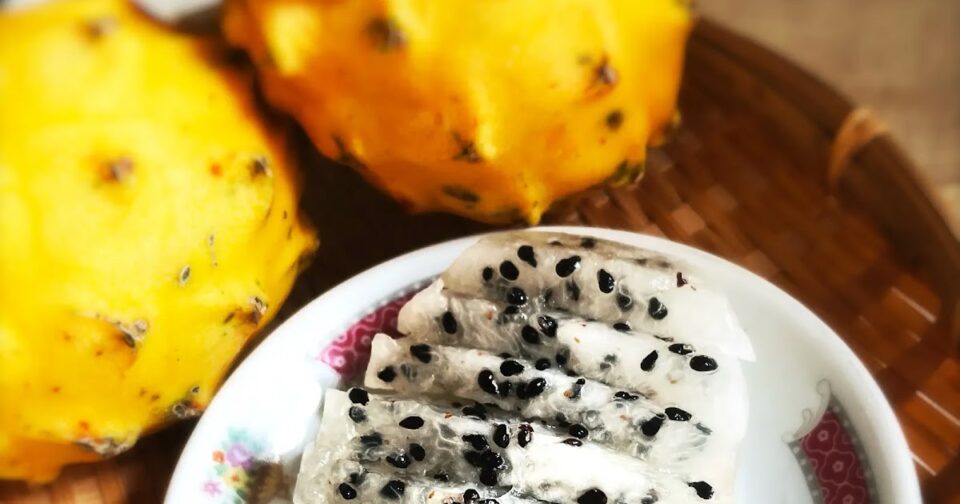This is our latest fruity discovery! We always love to share whenever we find a new fruit of amazing goodness and boy, this fruit is delicious!! I’m sure you have already seen red dragon fruit as it has been quite popular for many years now. But truth be told, we’ve been avoiding the red-skinned dragon fruit for a while, finding that the taste is pretty “meh” these days. Maybe due to excess production? I don’t know, just know that it doesn’t taste like it used to.
We found these yellow-skinned fruits in the clearance bin the other day and decided to try them, without even knowing they were related to red dragon fruit. After consuming it, we found that the white pulp of this yellow dragon fruit 麒麟果 was so pleasantly sweet and juicy that we actually went back to the store to buy more the next day, and the next… Nom, nom! It’s really good!
This yellow dragon fruit is also known as yellow pitahaya or pitaya. In Chinese they call this fruit 麒麟果, which translates as “qilin fruit” or “kirin fruit”. The quilin (kirin) 麒麟 is the mythical Chinese chimerian unicorn, part horse, part deer, part ox, and the only horned creature in the Chinese pantheon of legendary animals. A nice name for a little fruit to carry, huh? But now that we’ve tried the fruit I understand why it can carry such an important name…
| (Cactus S. megalanthus with fruits, photo by Jnn, CC from 2.1 JP DEED) |
The most interesting thing I discovered while researching this yellow dragon fruit is that it is actually the fruit of a cactus! Can you imagine it? I had no idea a cactus fruit could be so large, let alone so damn sweet and juicy. It makes those stories of desert travelers surviving on cacti a lot easier to believe, that’s for sure.
But don’t think that these delicious fruits are easy to pick. These fruits are protected by lots of long prickly thorns! You can see them sticking out in the photo above. These thorns must be cut from the fruits before shipping to the markets.
When buying, look for nice, heavy fruit with unblemished skin, except for the tips of the raised bumps which will have a scab from which the thorns have been cut. The color must be sunny yellow and the pulp quite firm. At home, keep it at room temperature for a couple of days to ripen to a darker yellow with the flesh yielding slightly when pressed. This will be the perfect time to eat the fruit.
Here is the yellow dragon fruit after a few days of ripening at home. See that the color has deepened and is more saturated. And the rinds are drier than in photo two above showing freshly purchased yellow dragon fruit.
Getting ready to eat is simple. Just cut some off at both ends.
Then use the knife to score the yellow skin at intervals, cutting only through the skin. It doesn’t have to be exact, you can see I missed the mark for a while. It’s difficult to cut because the white flesh is so soft.
After cutting the skin at intervals, peel off the skin. It should come off easily and cleanly. Like a banana!
Peeled yellow dragon fruit looks like this. A pale globe of succulence.
You can cut the fruit however you like. Nuts, rounds, etc. You can even just use a spoon to scoop it up! The white pulp has a soft, kiwi-like texture and is super juicy, not like watermelon where the juice is easily squeezed out, but still just as juicy. The taste is a delicate but not subtle sweetness that simply screams “refreshing!” This is one of those flavors you will remember and crave.
And do you see the black seeds inside the white pulp? Those will crumble deliciously as you eat the fruit. Ooooh yes, I love food with this sexy yellow dragon fruit!
That’s all for our latest, awesome fruit update. These delicious yellow dragon fruit are in season now, so look for them and try it for yourself. Dear readers, I guarantee you will love these delicious golden fruits as much as we do!
Frutta-ilicious at The Hong Kong Cookery:

